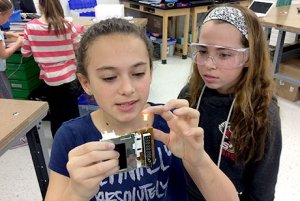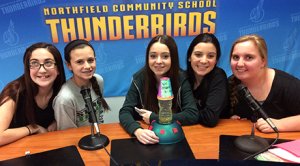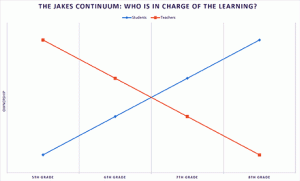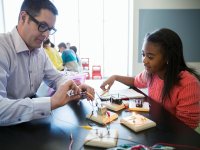Middle School Maker Journey: Review, Rethink, and Retool
In part ten of his year-long series, Kevin Jarrett reviews the learning and teaching experiences during the first year of his middle-school makerspace program.
Your content has been saved!
Go to My Saved Content.As the end of the school year is almost here (already?), our Digital Shop capstones are underway in earnest. Approaching the end of the program's first year, we’re asking ourselves, "What's gone well? What could be better? How should our program evolve for 2016-17?" In this month's post, I share some of our thoughts regarding enhancements to our makerspace design, curriculum, scheduling, and my own skill set.
Setting the Stage
"Less us, more them," says educational provocateur Gary Stager, who has influenced my thinking for a very long time. His honest, sharp-witted, student-centered worldview never wavers, and looking at one's own educational processes through his lens can be terrifying, especially if you're willing to confront your own inadequacies as an educator and do whatever is necessary -- including discarding significant amounts of past practice. Remember, kids, the goal is creating an educational environment that truly enriches, excites, and empowers learners. (It also helps when you have a courageous, visionary principal like Glenn Robbins.) Similarly, designer and educational consultant David Jakes, a longtime acquaintance whom I consider the spiritual father of our program, has had a similar outsized impact on my thinking. David likes to ask, "What kind of experience are you trying to create?" To the uninitiated, the question might seem odd. "Experience? I have standards to address, content to cover, instruction to deliver." Yes, but what matters is how you look at the tasks and how much risk you're willing and able (with the support of your leadership) to take.

Let's Hear From the Students
Which leads us to our first reality: We don’t know how the program should change next year because we haven't talked to the students yet. My colleague Colleen Kennedy and I are planning a series of focused listening sessions between now and June (a combination of electronic communications and small-group meetings). She'll interview students about my Digital Shop program. I'll interview her students about Black Mesa, the gamified learning management system (LMS) that she's been overseeing all year. We think this will lead to children being more open with their feedback as they likely associate each of us with each program.
Although we haven't yet nailed down specific or firm changes, some things are on the horizon, based on our experiences, what we've seen in other innovative programs, and our own observations during the year. First up: physical improvements in our makerspace/fablab.
Space
From the moment kids saw Digital Shop for the first time, we knew we'd hit the mark. They'd never seen or learned in anything like it. Their minds were blown by our collection of low- and high-tech tools, the visual "shop" aesthetic of the space, the large work tables, the ability to write on surfaces, and the freedom move around the room whenever they wanted. But where did we miss the mark? How can we make the space even more comfortable for students?
Seating
We intentionally didn't get stools for the space. The health risks of sitting too much are well documented, and kids sit for most of the school day. Yet stools remain a popular request, and informal polling indicates a 50/50 split on that question. Stools are a problem primarily because the undersides of our tables aren’t really available as storage areas, and we can't slide unused stools under the tables. The spaces between tables are also fairly tight, and kids sitting back to back might have difficulty when standing up and moving around. However, in the final analysis, if stools will allow the majority of kids to be more focused and productive, we'll get them.
My Desk
In my original design for the space, there was no teacher desk. The center of the room was to be a collaborative workspace where kids (and I) would naturally gravitate. That never happened, but not for reasons we expected. Our first attempt to build one of these awesome PVC student work tables became, thanks to a series of hilarious and unfortunate events, a creation we affectionately call Frankentable. Too high for student use, it became my de facto standing desk. I'd like to try realizing the original design goal of a central group worktable, but a lot depends on what else happens in the space. . .
Digital Shop's Footprint
Our movie studio occupied this room before we put in the makerspace. Designed and built by Robert Garguilo, our interim superintendent, it has served our needs well, but at a premium in terms of floorspace. If the studio is moved to another location in the school next year, our available footprint will grow by about 20 percent. Right now, I plan to preserve the greenscreen for projects while using that space for a casual seating area. I'm thinking an old couch or loveseat, bean bag chairs, a coffee table rescued from some curbside, a donated gaming console, and a modest LCD screen or TV. Basically, I want to create a small living room, a place to relax.

Our New Laser Cutter
We hope to integrate an Epilog Mini laser engraver into our program next year. Subtractive manufacturing (laser cutting) has many advantages over the additive kind (3D printing). What would we use it for? Check out this thread on the awesome K-12 FabLabs Google Group for examples and inspiration. But where will the thing physically go? In the center of the room where “Frankentable” is now? In the space vacated by the TV studio? We'll consider this puzzle when we demo the Mini for two weeks in May.
Considering Curriculum
Curriculum, or what we refer to collectively as the design experiences that power this program, came into being after deep research into and reflection on:
- Design as pedagogy
- Review of maker technologies and the skills needed to create them
- The New Jersey State Core Curriculum Content Standards in Technology
- 21st Century Life and Careers
- Our overarching goal to create a digital version of shop class where we made projects that matter
We'll let others judge how well we've achieved our objectives, but as we look toward 2016-17, several things are evident:
Tweaking Our LMS
Black Mesa's effectiveness as an instructional platform has yet to be fully determined. Mrs. Kennedy and I are reviewing the available data, plan to speak with students, and are considering what we've learned about student engagement, attention levels. willingness and ability to navigate web-based user interfaces, collaboration styles, and ultimately student tech skill levels. By year end or early summer, we'll complete our evaluation and identify the necessary changes. We already have some idea what modules we need to add next year, and which ones to diminish or eliminate. Under Colleen's leadership, this year's offline lessons are likely to continue. We don't see the program going away, just morphing.
Community Connections
Students will benefit from more frequent and more significant community connections. In a curriculum that integrates human-centered design needs, we need to connect our kids in significant ways to our local community.
More Access to Professionals
Our kids will benefit from authentic connections to experts like designer Meghan Holliday, whom we located via the fabulous (but not free) service Nepris. It would be fun (and not out of the question) to let the students loose within Nepris in search of experts to bring into their projects.
Reusing Design Experiences
Though a new capstone will have to be identified, this year's fifth-grade inculcation in design thinking will be necessary and important for next year's incoming students. I’m grateful that they're currently getting exposed to design thinking in my predecessor Betsy Connell's elementary technology program, and it will be my job to get them ready to embrace life in middle school as designers.
The Jakes Continuum

We want students to be responsible for their own learning as they progress through Digital Shop. The graph above, resulting from my recent conversation with David Jakes about our program, shows the desired relationship between teacher-directed and student-directed learning in Digital Shop. Referred to as the Jakes Continuum, it shows how, in fifth grade, the learning is primarily teacher-driven -- I will provide the structure, challenges, and framework. But by eighth grade, the roles reverse -- learning is almost entirely student-driven. I'm their resource, but they drive the work. Essentially, the continuum means that every the year kids in my program become more responsible for their own learning until, by eighth grade, they have the tools, confidence and worldview necessary to start the year with a single provocation: "How do you want to change the world?"
Beyond Digital Shop
We need to push out of the silo, more aggressively encouraging and supporting the ideas of making and design thinking outside of Digital Shop. We're currently partnering with math classes during our "writing across the curriculum" period. It's working well enough, but we plan to partner with science classes next year during the same writing block. This seems like a great fit that might provide interesting opportunities for interaction. We're also looking at the EPICS@Purdue program. Their Middle School Curriculum (PDF) could provide a nice framework and, more importantly, support a range of innovative human-centered design projects.
The Schedule
Digital Shop is a six-week rotation of five-day Design Experiences, with each class meeting 40 minutes or less (due to transition time.) We know this isn't enough. While the five consecutive days are great, the periods don't allow for deep, engaging work. We have administrative support for longer class periods, but the problem is fitting them into the existing lineup. Since I'm told that middle school scheduling is similar in complexity to programming a NASA flight control system, I'm not optimistic about this changing much in 2016-17.
My Skills
Upgrade Pending
I've never been more aware of my limitations as an educator than I have this year. My inability to quickly and effectively guide students when they needed it most has been a source of personal frustration. So, one of my goals this summer is to find a Matrix Headjack and upgrade as many of my tech skills as I possibly can.
Formal Training
I’m thrilled to be attending the Nueva Design Thinking Institute in June. It will be my first formal training on design other than last summer's work with David Jakes. I can't wait to learn more about Nueva's methods and determine what we can improve on next year.
Beyond the Prototypes
We need to substantially up our collective game next year from a technical perspective, so that our prototypes can become more sophisticated and operationally capable. Put another way, we need to make things that matter and actually work. We need to move beyond prototypes. And I'm the one holding us back.
So that's what lies ahead for our program in September. Do you have any questions or comments? How did your year go? What did you learn? What will you change? Next month, we'll finish the series with a recap on the capstones in specific and the course in general. Until then, see you in the comments!
